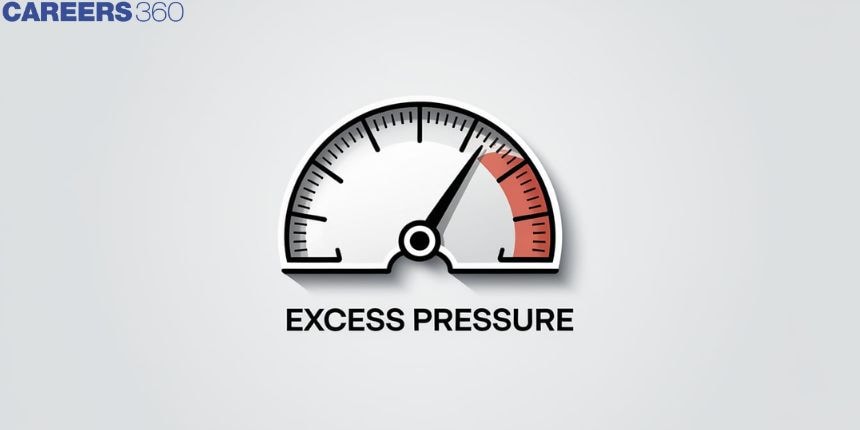Excess Pressure
Ever blown a soap bubble and then stopped to wonder why it holds its shape, or why small droplets of water are spherical? The reason for all phenomena lies in the concept of excess pressure. The excess pressure is additional pressure inside a liquid drop or a soap bubble as compared to the outside. The difference in pressure is caused by surface tension, a force that acts along the surface of a liquid, causing it to contract and minimize its surface area. Understanding excess pressure sheds light on these phenomena of liquid drops, bubbles, and many other fluid dynamics.
JEE Main 2025: Physics Formula | Study Materials | High Scoring Topics | Preparation Guide
JEE Main 2025: Syllabus | Sample Papers | Mock Tests | PYQs | Study Plan 100 Days
NEET 2025: Syllabus | High Scoring Topics | PYQs | Crack NEET in 2 months - Study Plan
- What is Excess Pressure
- Solved Example Based on Excess Pressure
- Summary

This article will cover the concept of Excess pressure inside a liquid drop & soap bubble. This is the part of chapter Properties of Solids and Liquids which is a crucial chapter in Class 11 physics. It is not only crucial for board exams but also for competitive exams like the Joint Entrance Examination (JEE Main), National Eligibility Entrance Test (NEET), and other entrance exams such as SRMJEE, BITSAT, WBJEE, BCECE and more. Over the last ten years of the JEE Main and NEET(from 2013 to 2023), a total of ten questions have been asked on this concept.
What is Excess Pressure
The difference in pressure between the two sides of the liquid surface is known as Excess Pressure.
Cause of Excess Pressure
Drop or bubble tends to contract and so compresses the matter enclosed, due to the property of surface tension. Thus to prevent further contraction, internal pressure inside the Drop or bubble increases. This internal pressure increases until the equilibrium is achieved. So that is why in equilibrium the pressure inside a bubble or drop is greater than outside. And this difference of pressure between the two sides of the liquid surface is called excess pressure.
Excess Pressure in Different Cases
- Excess pressure for plane surface
ΔP=0
means no difference in pressure.
- Excess pressure for concave surface
ΔP=2TR
Where,
T- Surface Tension
R- Radius
- Excess pressure for a convex surface
ΔP=2TR
- Pressure Difference in Water Droplet
ΔP=2TR
- Change in Pressure of bubble in the air
ΔP=(2TR)×2=4TR
Excess pressure is inversely proportional to the radius of the bubble (or drop).
Recommended Topic Video
Solved Example Based on Excess Pressure
Example 1: A small soap bubble of radius 4 cm is trapped inside another bubble of radius 6 cm without any contact. Let p2 be the pressure inside the inner bubble and p0, the pressure outside the outer bubble. The radius (in cm ) of another bubble with a pressure difference p2−p0 between its inside and outside would be :
1) 12
2) 2.4
3) 6
4) 4.8
Solution:
Change in Pressure of bubble in air -
ΔP=(2TR)×2=4TR
- wherein
T- Surface tension
R- Radius

p2−p1=4sR1p1−p0=4sR2p2−p0=4s(1R1+1R2)1R=1R1+1R2R=R1R2R1+R2=4∗64+6 cm=2.4 cm
Hence, the answer is option (2).
Example 2: Two soap bubbles coalesce to form a single bubble. If V is the subsequent change in the volume of contained air and S the change in total surface area, T is the surface tension and P is atmospheric pressure, which of the following relations is correct?
1) 4PV+3ST=0
2) 3PV+4ST=0
3) 2PV+3ST=0
4) 3PV+2ST=0
Solution:
Change in Pressure of bubble in air -
ΔP=(2TR)×2=4TR
- wherein
T- Surface tension
R- Radius



(P+4Tr1)(4π3r13)+(P+4Tr2)4π3r23=(P+4Tr)4π3r3PV+4T3(4πr12+4πr22−4πr2)=0⇒3PV+4TS=0
Hence, the answer is option (2).
Example 3: A soap bubble of radius 3 cm is formed inside another soap bubble of radius 6 cm. The radius of an equivalent soap bubble which has the same excess pressure as inside the smaller bubble with respect to the atmospheric pressure is -------- cm.
1) 2
2) 8
3) 4
4) 1
Solution:
R=3 cm=3×10−2 m

p1−p2=4Tr1→(1)p2−p0=4Tr2→(2)p′−p0=4Tr→(3)∵p1−p0=p′−p0 (Given) 4Tr1+4Tr2=4Tr13+16=1r918=1rr=2 cm
Hence, the answer is option (1).
Example 4: There is an air bubble of radius 1.0 mm in a liquid of surface tension 0.075 nm−1 and density 1000 kg m−1 at a depth of 10 cm below the free surface. The amount by which the pressure inside the bubble is greater than the atmospheric pressure is Pa___.(g=10 ms−2)
1)1170
2)1140
3)1150
4)1160
Solution:
Pin =P0+ρgh+2Tr

Pin −P0=1000×10×0.1+2×0.0750.001=1000+150Pin −P0=1150 Pa
Hence, the answer is option (3).
Example 5: Which of the following relations is correct? ( P1 =pressure inside drop, P2 = pressure outside drop).
1) )P1−P2=2TR
2) P2−P1=2TR
3) P1−P2=4TR
4) P2−P1=4TR
Solution:
Excess pressure for the drop :
ΔP=2TR
P1>P2 (pressure inside is higher than the pressure outside)
P1−P2=2TR
Hence, the answer is option (1).
Summary
The excess pressure is additional pressure inside a liquid drop or a soap bubble as compared to the outside. The difference in pressure is caused by surface tension, a force that acts along the surface of a liquid, causing it to contract and minimize its surface area. Understanding excess pressure sheds light on these phenomena of liquid drops, bubbles, and many other fluid dynamics.
Also Read
02 Dec'24 12:36 AM
21 Nov'24 01:48 PM
20 Nov'24 10:28 AM
18 Nov'24 05:26 PM
12 Nov'24 11:55 PM
12 Nov'24 11:20 PM
12 Nov'24 09:27 PM
25 Sep'24 06:28 PM
25 Sep'24 11:47 AM
24 Sep'24 09:56 PM